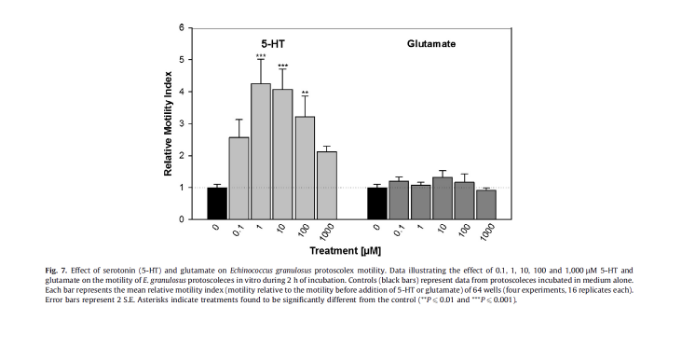
Serotonin (5-hydroxytryptamine, 5-HT) is an important neuroactive and morphogenetic molecule in several metazoan phyla, including flatworms. Serotoninergic nervous system studies are incomplete and 5- HT function/s are unknown in Echinococcus spp., the flatworm parasites that cause hydatid disease. The role of 5-HT as a neurotransmitter in E. granulosus was evaluated by determining the effect of this substance on protoscolex motility. The addition of 5-HT to protoscoleces induced a significant increase in motility for short time periods. Taking into account the important roles of 5-HT in parasite biology and the divergence of 5-HT pathway genes with respect to human counterparts, the serotoninergic system could be considered as an amenable drug target against hydatid disease.
Materials and Methods:
Protoscoleces were cultured in DMEM high glucose medium (Gibco, USA) with 50 lg/ml of gentamicin and transferred to U-shape 96-well microplates (Greiner Bio-One, Germany) with 20–200 parasites per 100 ll for no more than 48 h. Movement was measured as described for Caenorhabditis elegans (Simonetta and Golombek, 2007) using a worm tracker device (WMicrotracker). The relationship between motility and the number of organisms per well was established by measuring serial dilutions of parasites.
Results:
Treatment of protoscoleces with increasing concentrations of 5- HT induced significant changes in motility (Fig. 7) after short periods of time (2 h). An increase in motility could be observed at 0.1 lM (Fig. 7, Supplementary Movie S1) and became significant at 1 lM (P < 0.001; Fig. 7). Motile activity started to decrease at 100 lM, which could be due to a constant contraction effect caused by these elevated concentrations. The incubation of protoscoleces in the presence of 0.1, 1, 10, 100 and 1,000 lM glutamate (an unre-lated neurotransmitter) caused no variation in motor activity (Fig. 7).

…………………………………………………………………………………………………………………………..
Int J Parasitol. 2013 Jul;43(8):647-59. doi: 10.1016/j.ijpara.2013.03.006. Epub 2013 Apr 29.
Camicia F, Herz M, Prada LC, Kamenetzky L, Simonetta SH, Cucher MA, Bianchi JI, Fernández C, Brehm K, Rosenzvit MC.
